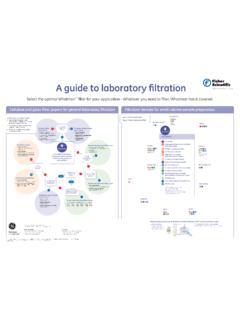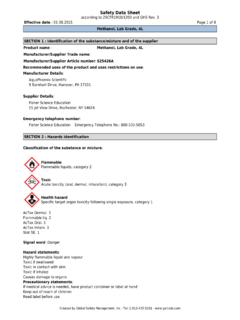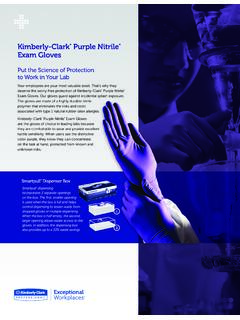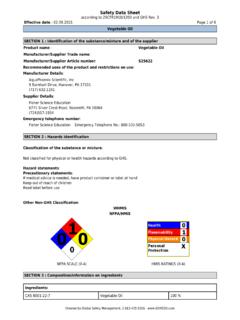Transcription of Safety Data Sheet - Fisher Scientific
1 Safety data Sheet according to 29 CFR1910/1200 and GHS Rev. 3. Effective date : Page 1 of 6. Sodium Sulfate,Anhydrous, SECTION 1 : Identification of the substance/mixture and of the supplier Product name : Sodium Sulfate,Anhydrous, Manufacturer/Supplier Trade name: Manufacturer/Supplier Article number: S25568. Recommended uses of the product and uses restrictions on use: Manufacturer Details: AquaPhoenix Scientific 9 Barnhart Drive, Hanover, PA 17331. Supplier Details: Fisher Science Education 15 Jet View Drive, Rochester, NY 14624. Emergency telephone number: Fisher Science Education Emergency Telephone No.: 800-535-5053. SECTION 2 : Hazards identification Classification of the substance or mixture: Hazards Not Otherwise Classified - Combustible Dust Hazard statements: Precautionary statements: If medical advice is needed, have product container or label at hand Keep out of reach of children Read label before use Do not eat, drink or smoke when using this product Combustible Dust Hazard: : May form combustible dust concentrations in air (during processing).
2 Other Non-GHS Classification: WHMIS. NFPA/HMIS. NFPA SCALE (0-4) HMIS RATINGS (0-4). SECTION 3 : Composition/information on ingredients Created by Global Safety Management, Inc. -Tel: 1-813-435-5161 - Safety data Sheet according to 29 CFR1910/1200 and GHS Rev. 3. Effective date : Page 2 of 6. Sodium Sulfate,Anhydrous, Ingredients: CAS 7757-82-6 Sodium Sulfate >95 %. Percentages are by weight SECTION 4 : First aid measures Description of first aid measures After inhalation: Move exposed individual to fresh air. Loosen clothing as necessary and position individual in a comfortable medical advice if discomfort or irritation breathing difficult, give oxygen. After skin contact: Wash affected area with soap and water. Rinse/flush exposed skin gently using water for 15-20 minutes. Seek medical advice if discomfort or irritation persists.
3 After eye contact: Protect unexposed eye. Rinse/flush exposed eye(s) gently using water for 15-20 minutes. Remove contact lens(es) if able to do so during rinsing. Seek medical attention if irritation persists or if concerned. After swallowing: Rinse mouth thoroughly. Do not induce vomiting. Have exposed individual drink sips of water. Seek medical attention if irritation, discomfort or vomiting persists. Most important symptoms and effects, both acute and delayed: Irritation, Nausea,Headache, Shortness of breath.;. Indication of any immediate medical attention and special treatment needed: If seeking medical attention, provide SDS document to physician. SECTION 5 : Firefighting measures Extinguishing media Suitable extinguishing agents: If in laboratory setting, follow laboratory fire suppression procedures.
4 Use appropriate fire suppression agents for adjacent combustible materials or sources of ignition For Safety reasons unsuitable extinguishing agents: Special hazards arising from the substance or mixture: Combustion products may include carbon oxides or other toxic decomposition can lead to release of irritating gases and generating dust; fine dust dispersed in air in sufficient concentrations, and in the presence of an ignition source is a potential dust explosion hazard. Advice for firefighters: Protective equipment: Use NIOSH-approved respiratory protection/breathing apparatus. Additional information (precautions): Move product containers away from fire or keep cool with water spray as a protective measure, where spark-proof tools and explosion-proof equipment. SECTION 6 : Accidental release measures Personal precautions, protective equipment and emergency procedures: Wear protective equipment.
5 Transfer to a disposal or recovery respiratory protective device against the effects of fumes/dust/aerosol. Ensure adequate ventilation. Environmental precautions: Collect contaminated soil for characterization per Section 13. Methods and material for containment and cleaning up: If in a laboratory setting, follow Chemical Hygiene Plan into properly labeled containers for recovery or disposal. Dust deposits should not be allowed to accumulate on surfaces, as these may form an explosive mixture if they are released into the atmosphere in sufficient concentration. Avoid dispersal of dust in Created by Global Safety Management, Inc. -Tel: 1-813-435-5161 - Safety data Sheet according to 29 CFR1910/1200 and GHS Rev. 3. Effective date : Page 3 of 6. Sodium Sulfate,Anhydrous, the air ( , clearing dust surfaces with compressed air).
6 Collect solids in powder form using vacuum with (HEPA. filter). Reference to other sections: SECTION 7 : Handling and storage Precautions for safe handling: Minimize dust generation and accumulation. Wash hands after handling. Follow good hygiene procedures when handling chemical materials. Do not eat, drink, smoke, or use personal products when handling chemical substances. Use only in well ventilated contact with eyes, skin, and clothing. Conditions for safe storage, including any incompatibilities: Provide ventilation for containers. Store in cool, dry conditions in well sealed containers. Store with like hazards SECTION 8 : Exposure controls/personal protection Control Parameters: , , OSHA PEL TWA (Total Dust) 15 mg/m3 (50 mppcf*). , , ACGIH TLV TWA (inhalable particles) 10 mg/m3.
7 Appropriate Engineering controls: Emergency eye wash fountains and Safety showers should be available in the immediate vicinity of exhaust ventilation or other engineering controls to keep the airborne concentrations of vapor or dusts (total/respirable) below the applicable workplace exposure limits (Occupational Exposure Limits-OELs) indicated under a fume hood. It is recommended that all dust control equipment such as local exhaust ventilation and material transport systems involved in handling of this product contain explosion relief vents or an explosion suppression system or an oxygen deficient that dust-handling systems (such as exhaust ducts, dust collectors, vessels, and processing equipment) are designed in a manner to prevent the escape of dust into the work area ( , there is no leakage from the equipment).
8 Respiratory protection: Not required under normal conditions of use. Use suitable respiratory protective device when high concentrations are present. Use suitable respiratory protective device when aerosol or mist is formed. For spills, respiratory protection may be advisable. Protection of skin: The glove material has to be impermeable and resistant to the product/. the substance/ the preparation being of the glove material on consideration of the penetration times, rates of diffusion and the degradation. Eye protection: Safety glasses with side shields or goggles. General hygienic measures: The usual precautionary measures are to be adhered to when handling chemicals. Keep away from food, beverages and feed sources. Immediately remove all soiled and contaminated clothing. Wash hands before breaks and at the end of work.
9 Do not inhale gases/fumes/dust/mist/vapor/aerosols. Avoid contact with the eyes and skin. SECTION 9 : Physical and chemical properties Created by Global Safety Management, Inc. -Tel: 1-813-435-5161 - Safety data Sheet according to 29 CFR1910/1200 and GHS Rev. 3. Effective date : Page 4 of 6. Sodium Sulfate,Anhydrous, Appearance (physical Explosion limit lower: Not Determined White solid state,color): Explosion limit upper: Not Determined Odor: Odorless Vapor pressure: Not Determined Odor threshold: Not Determined Vapor density: Not Determined pH-value: 4 - 9 110 g/l aq. sol Relative density: Not Determined 884 - 888 C / - Melting/Freezing point: Solubilities: Material is water soluble. F. Boiling point/Boiling Partition coefficient (n- Not Determined Not Determined range: octanol/water): Flash point (closed Auto/Self-ignition Not Determined Not Determined cup): temperature: Decomposition Evaporation rate: Not Determined Not Determined temperature: a.
10 Kinematic:Not Flammability Determined Not Determined Viscosity: (solid,gaseous): b. Dynamic: Not Determined Density: Not Determined SECTION 10 : Stability and reactivity Reactivity: Chemical stability:No decomposition if used and stored according to specifications. Possible hazardous reactions:None under normal processing. Conditions to avoid:Store away from oxidizing agents, strong acids or generation, moisture, excess heat. Incompatible materials:Strong oxidizing agents, strong acids, aluminum, magnesium. Hazardous decomposition products:Carbon oxides (CO, CO2).Oxides of sulfur, sodium oxide. SECTION 11 : Toxicological information Acute Toxicity: Oral: 5989mg/kg (Sodium Sulfate) LD50 orl - rat: Chronic Toxicity: No additional information. Corrosion Irritation: No additional information.










